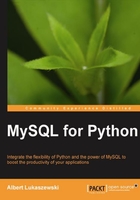
Record retrieval is without doubt the most common activity employed with regard to MySQL and other relational databases. Like most computer programs, MySQL functions on the basis of being invoked with parameters and returning results in accordance with them. As we seen, Python acts as an intermediary to that process. We can use it to access MySQL, login, and connect to a database of our choice.
In this chapter, we will look at the following:
- Forming a MySQL query directly
- Passing a query to MySQL
- User-defined variables in a MySQL query
- Determining characteristics of a database and its tables
- Changing queries dynamically, without user input
Working through each of these points will help you at the end of the chapter, when we get to the project: a command-line search tool.
The four basic functions of any persistent storage system like MySQL spell CRUD:
- Create
- Read
- Update
- Delete
These are key concepts, which each of the basic MySQL commands reflect.
There is nothing technical about the words themselves, but the concepts are very important. They represent the four activities that you can expect to be able to do in every relational database system you use. There are several alternatives to this acronym and keyword series (for example, SCUD for "select, create, update, and delete" or SIDU for "select, insert, delete, and update"). The point of each of these is that database functionality boils down to two sets of opposing activities:
- Creating and deleting database objects (for example, databases, tables, records)
- Inserting and reading data (that is writing and reading)
Each of these will be addressed in the coming chapters. In this one, we start with reading data using SELECT.